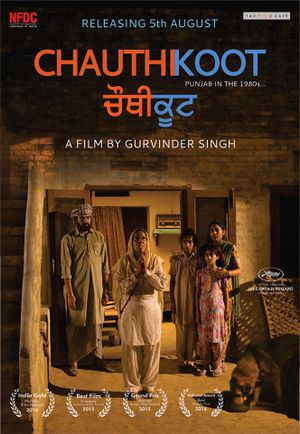Chauthi Koot Reviews and Ratings

-
The narrative of this Gurvinder Singh film unfolds unhurriedly and still you do not stir from your seats. You watch with a growing sense of dread, praying for safety of innocents in the frame, both two and four-legged.
-
Gurvinder Singh’s Chauthi Koot (The Fourth Direction) is one of the best films I’ve seen to have come out of India in recent times.
Screened at Cannes Film Festival 2015 in the Un Certain Regard section along with Masaan, this film is based on the short stories The Fourth Direction and I Am Feeling Fine Now from Indian author Waryam Singh Sandhu’s 2005 collection Chauthi Koot.
Set in 1980s Punjab, this film is about the Sikh separatist movement and the effects it had on people in that state.
It is one of the most violent films I’ve seen and yet I can hardly recall a drop of blood being shown on screen. For the violence I’m talking about is not of the physical kind, even though there are scenes of physical violence in this film. The kind of violence I’m talking about is one that lingers in the mind – pure psychological violence. For it is the helplessness of our characters that makes us emphatise with them. Caught in between the militants and the police, they are left with nowhere to go and they must do what both parties tell them or they could end up being arrested or even worse, killed.
The film starts off with two passengers trying to board the last train to Amritsar. They are told that for security reasons given the current atmosphere, they cannot be allowed on-board and must try again tomorrow. They beg and plead to anyone in sight – be it cop, guard or railway employee. Conversing in their local Punjabi, our passengers beg these people to emphatise with them and understand their plight (much like we will over the course of this film). They finally force their way in, to find a few others there. One of these two passengers start to recite an incident from a few months ago.
We are then seamlessly transported into interior Punjab. The aforementioned passenger accompanied by his wife and child is lost trying to find the residence of his in-laws. They finally decide to shout for help and the people who answer, in a masterful move by Singh, are the ones our focus is shifted onto for the major part of the film.These people comprise of a family of about 10 or so along with a dog named Tommy. They are self-sufficient and seemed to have lived peacefully before this entire unfortunate ordeal. They are a family that just wants to be left alone and to have nothing to do with militants or the police. This is impossible however, mainly because of their dog Tommy. Much like other dogs, Tommy barks. And that is a problem. Since the militants usually move about at night and the barking may give away their location. So the militants tell Joginder, head of the family, that the dog must be done away with.
This film could be called a technical masterpiece. For the cinematography, sound design, screenplay, performances all seem flawless. The brilliantly captured scenic landscapes by DoP Satya Rai Nagpaul along with the incredibly detailed sound design that captures everything from the rustling of the tall grass to the barking and whimpering of Tommy leave us in awe. Dialogue and delivery are on-point, capturing nuances of what it is like to be Punjabi. Production design brings about the simplicity of the lives of these people and the editing in this film holds everything together. The pacing of this film is steady and slow, which may turn off the majority of viewers. However, the impression it has no the ones that it connects with will stay for a long long time.
Gurvinder Singh does what Chaitanya Tamhane did with Court. He uses the story of one unit to talk about something much larger. Court spoke about everything wrong with the judicial system in India through the story of the death of a sewage worker. Chauthi Koot speaks about the turbulent atmosphere at the time of Operation Bluestar through the story of this one family.
The passengers are almost used as a McGuffin for where they go from there isn’t really of any importance to the story Singh wants to tell us.
I was left deeply moved after this film. More moved than I was after Masaan. For what I learnt in a way from this film is that in life, everything doesn’t always turn out to be fine. Sometimes things don’t go our way and we must somehow find a way to deal with them. And that thought is more scary and violent than any other.
-
This is a crafty move on the director’s part, as it translates facts into a humane narrative without giving much room for prejudice. Hope rears its head when needed the most. The humanitarian perspective is the movie’s biggest win.
-
The film boasts of a confident command of tone with magnetic performances holding your attention, and film leaves many things unreciprocated. But only if you want to grasp the agonising lives of some of these men and women, and look deeper, you will appreciate. Chauthi Koot is the kind of film that comes once in a while, and therefore, is a must-watch!
-
Lovers of good cinema should not miss this opportunity to watch one of the best Indian films of 2016.
-
Gurvinder Singh deserves full marks for this National Award winner. He narrates a simple story which says a lot more than it literally does.
-
Much of the power of Chauthi Koot is in that which is not spelt out or spoken of, but which the audience is made to feel and live through, along with the characters — their lives and relationships — on screen.

















